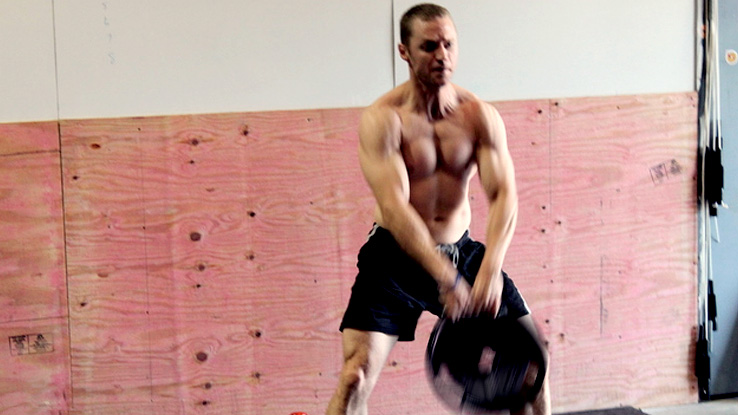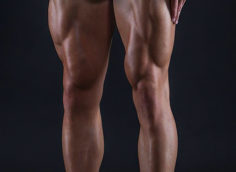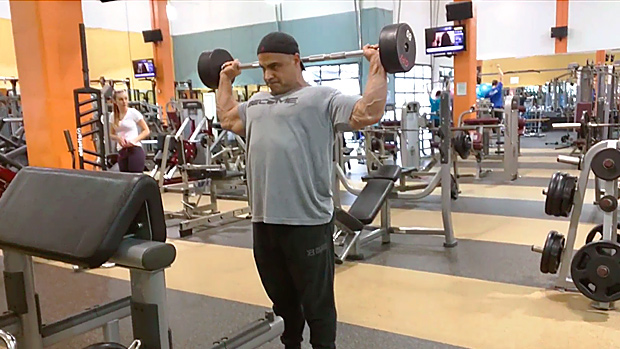Having trained for over a decade in university fitness facilities, access to equipment, particularly heavy kettlebells, has always been something I've had to work around. Furthermore, peak hours at many collegiate recreational sport facilities pose their own unique set of challenges as oftentimes the only unoccupied equipment may be a set of Olympic plates hanging on the overpopulated bench press station.
Fortunately, dealing with these challenges has been a blessing in disguise. It's forced me to devise unique alternatives that are not only suitable replacements for their traditional counterparts, but may actually serve as more intense and effective movement variations.
When I first began tinkering with using a single 45-pound plate in lieu of kettlebell swings, I soon realized that not only was this a movement that I could perform at nearly any facility due to easy accessibility, but that it also offered unique benefits.
First, driving a plate through your legs immediately forces the hips to open up and spread maximally in order to accommodate the wide implement. Second, plate swings greatly assist in eliminating one of the most common pitfalls associated with swings, which is squatting rather than hinging at the hips.
If you squat rather than hinge, you'll hit the ground because of the height of the plate. This teaches you to hinge and not let the weight pull you down. Instead, you'll learn to drive the weight back during the eccentric phase of the swing.
There are additional perks to performing double plate swings. First, they allow you to use anywhere from a total of 50 pounds (using two 25-pound plates) to as high as 90 pounds (using two 45-pound plates). For many lifters, swinging 90 pounds is more than sufficient to elicit the appropriate training stimulus, not to mention the fact that 90 pounds in the form of plates will feel heavier and more intense than the same load applied with kettlebells.
The double plate swing is also an incredible forearm and grip workout. With kettlebells, the hands tend to move naturally and rhythmically, whereas plates have to be essentially manhandled in order to control them properly.
Also, supinating the hands into a more neutral position helps teach the neuromuscular system to pull the scapula medially, as well as reinforcing proper scapular retraction and depression. Simply put, the neutral grip engrains the idea of pulling the shoulder blades down, back, and medially towards the spine, a maneuver that all lifters should be emphasizing in their training programs.
The main difference here is that you swing the plates from the sides rather than the front of the body. This variation of the traditional swing may be one of the best for athletes. Not only does swinging the plates from the side of the body present a unique stimulus that's difficult to replicate with any other form of external resistance, but there are several unique advantages to this intense exercise.
First, the side plate swing will have more specific transfer to close-stance movements including conventional deadlifts, trap bar deadlifts, Olympic lifting variations, Romanian deadlifts, and bent over rows. Secondly, the movement is more specific to jumping due to the similar stance width employed. Although many would argue that hip extension is hip extension, period, performing dynamic hinge activities in a more sport-specific fashion may provide a highly valuable training alternative for athletes.
Another unique benefit is the greater range of motion the plates must travel as a result of using a taller body position. Not only do the hips have to extend more forcefully to propel the load to the proper height, but there are also greater deceleration forces involved during the eccentric component due to the momentum buildup accrued from the larger drop height.
Lastly, I've occasionally run into the issue where some individuals feel a bit apprehensive swinging a heavy object in between their legs, particularly when one of the common coaching cues is "smack your butt with the kettlebell" at the turnaround position. Although this is a fear that should be quickly put to rest with proper coaching and improved kinesthesia, some people inevitably feel more comfortable with the load at their sides rather than in between their legs, if you catch my drift.
I'm a huge fan of eccentric isometrics (isometrics held at the stretched position), not only for the intense challenge they present by increasing intramuscular tension, but also for their ability to create efficient motor programs and improve sensory integration.
One of the most effective eccentric isometrics I use with athletes to prepare them for swings and to establish a strong general motor program for the hinge position is the isometric plate hinge. It's one of the most simple, yet effective movement prep activities you can do.
Simply take a 5 or 10-pound plate and drive it back between your legs as if you were performing a cable pull-through. Focus on keeping a neutrally-arched spine (not excessive), shoulders pulled down and back, packed head, weight emphasized on the outer heels, hips and knees spread, and core tight.
Hold each rep for 3-5 seconds and come back up smoothly but forcefully focusing on creating a powerful contraction in the glutes. If you have difficulty with any of the previously described plate swing variations or simply are in need of a tune-up on your swing/hinge technique, this lower-intensity preparatory movement may be one you want to perform for several minutes each training session.
Anyone who's ever tried any variation of a bottoms-up kettlebell exercise knows how demanding these can be on the grip, forearms, shoulders, and core, not to mention the value they have on overall movement mechanics and scapular stabilization. Variations performed with plates offer similar if not greater benefits, as the difficulty is often higher.
There are several benefits here. First, the weight can be swung/pulled from the side, thereby enforcing a strong hip hinge pattern. When you clean a barbell from the front of the body, it can precipitate more of a squatting position rather than the desired hinging position.
When the weights are pulled in back of the body as is the case with plates, this naturally drives the hips back into flexion (similar to jumping), creating a scenario that emphasizes maximal hip drive and reciprocal inhibition of the glutes on the proceeding hip extension.
This is analogous to a sling-shot-effect in which case the hips are fully cocked back (maximal co-contraction) before exploding forward. Furthermore, having the weight at the sides will produce less shear forces on the spine due to the load being closer to the center of mass rather than in front of it.
Bottoms-up plate-cleans also allow a much greater range of motion at the hips compared to other traditional hang clean variations. For example, performing a hang clean with a barbell is most often done above the knees. While this minimizes risk of injury and ensures the simplest method for performing the movement, the range of motion produced by the hips is relatively small.
Plate cleans call a much greater range of motion into play as driving the weights back to initiate the movement inherently causes fuller hip flexion at the bottom and ultimately more forceful hip extension at the top. Although similar advantages are seen with kettlebells, performing cleans with plates allows a narrow-foot-stance position, mimicking more traditional pull variations not commonly witnessed with their kettlebell counterparts.
If you've ever tried a bottoms-up press with kettlebells, you'll immediately understand the difficulty this next exercise poses. The bottoms-up plate press is done in the exact same manner as the kettlebell version, only using plates, but the height of the plates as well as their awkward nature makes this a more grueling variation. Remember, as the plates get heavier, they also get taller and harder to balance. Be prepared to focus like a Jedi as this may be one the more difficult exercises you'll ever attempt.
The next exercise can be somewhat dangerous. I recommend you attain a fairly high level of competency on all the above exercises before even attempting bottoms-up plate snatches.
It's also advisable to perform these in an open area with few people close by for two reasons, both of which I found out the hard way. First, this is a very humbling exercise. Be prepared to fail numerous times and the fewer people watching you nearly kill yourself, the better. Secondly, this one can get a bit messy, and if you're going to kill yourself it's best to not take anyone else down with you.
Warnings aside, there are several factors that make this one of the most effective exercise selections. Other than a close-grip barbell snatch from the floor (a variation that's rarely done), no exercise requires such a large displacement of the loading implement as the bottoms-up plate snatch. Taking the weight from the bottom at shin height to a close-arm position in the catch at the top requires incredible power and hip drive as the plates have to travel a total of six to eight feet, depending on height and limb length.
Furthermore, you won't be dropping under the plates in order to catch them as you would with the barbell variation. In other words, you either have to propel the weight to standing height with arms fully extended, all in one powerful motion, or you won't succeed. Finally, the degree of core, forearm, and overall upper body activation required to catch the plates at the top in a stable position is incredibly high. If you're looking for a new exercise that combines full body strength, power, coordination, and stabilization, look no further.
- There's a learning curve for most of these movements, so start with 25-pound plates and progress from there.
- If 45-pound plates aren't challenging enough, Ivanko makes 55-pound (25kg) plates with handles. If this still doesn't do the job, then you have my utmost respect and admiration.
- The type of plate makes a difference. True Iron Grip plates with straight angles are easier to grip and stabilize than those with circular holes used in the videos.
- All of the movements listed can be performed during any portion of the workout. However, make sure excessive fatigue doesn't cause degradation of technique.
- Some spinal extension is acceptable during the bottoms-up overhead variations. However, most of this should be coming from the T-spine rather than the cervical or lumbar regions and it shouldn't be excessive.
- Some trainees will find the single arm versions (i.e., single arm swings, cleans, presses, etc.) to be easier as you can focus more of your neural drive to an individual limb. In contrast, if anti-rotation and core stabilization are a weakness, then single-arm versions may be more difficult.
- To focus even more on core stabilization, try performing these with offset loads (i.e., a 45-pound plate in one hand and a 35 or 25-plate plate in another).
- For the overhead movements, make sure you're proficient at standing overhead presses with dumbbells before progressing to these bottoms-up plate variations.




